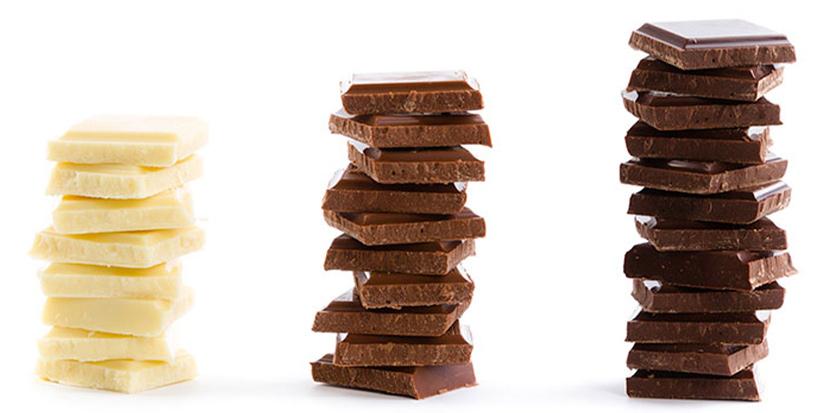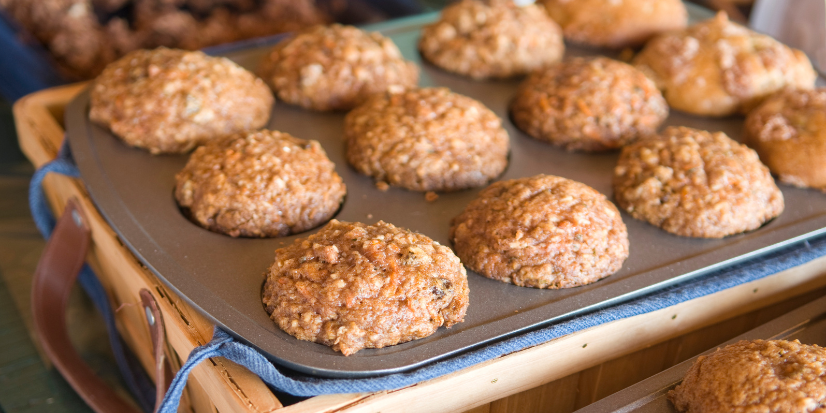Every year, my parents visit during Thanksgiving, and each year we hit the nearest Costco for Black Friday sales and large amounts of almond butter. As we went to check out this year, with our cart nearly overflowing, my dad made a point to walk through the snack aisle. He placed two large bags of dark chocolate pretzel crisps in the cart. Half a second later, he added two more bags, then two more…then two more.

As he was about to transfer bags number nine and ten, I stepped in with my hands in the air and said, “What are you doing?! Do you really need TEN bags?” With enthusiasm, he replied, “Well they’re on sale, and they’re healthy!” as he pointed to the words “dark chocolate” on the bag. The dietitian in me quickly replied, “Just because it says dark chocolate, that doesn’t mean it’s healthy.” After a short pause, my dad looked at my mom, looked back at me, and very slowly put the bags in the cart, then took off running toward the register with the biggest smirk I’ve ever seen, and, his ten bags of “healthy” dark chocolate covered pretzels. So, was he right to think dark chocolate is healthy? Or is it just another deception by food manufacturers to trick us into thinking it’s a healthy product? Today, I’ll uncover if that dark chocolate bar is your friend or foe.
Chocolate Basics
A delicious piece of chocolate all starts with the cacao tree. The tree, pod, and bean are referred to as “cacao,” while “cocoa” is reserved for the bean once fermented, dried, and roasted. After roasting, the nibs (meat of the bean) are finely ground into cocoa liquor (or cocoa mass), which is pressed to eventually yield cocoa powder and cocoa butter.
Dark vs. Milk vs. White
The difference all comes down to one or two ingredients. Dark chocolate requires only cocoa liquor, cocoa butter, and sugar. Add milk powder and you’ve got milk chocolate. Keep the milk powder and take away the cocoa liquor and you’ve got yourself sweet, creamy white chocolate. Since white chocolate contains no cocoa liquor, some do not consider it true chocolate.
Chocolate Math:
Dark Chocolate = cocoa liquor + cocoa butter + sugar
Milk Chocolate = cocoa liquor + cocoa butter + sugar + milk powder
White Chocolate = cocoa butter + sugar + milk powder
Understanding Percent Cacao
Before we dig in, it should be noted that regardless of the percent cacao, chocolate is relatively high in calories, sugar, and fat. As the cacao percentage increases, total fat and saturated fat increase, while carbohydrates and sugar decrease. This said, 60% dark chocolate has more sugar and carbohydrates than 85% dark chocolate, which has more fat (from the cocoa butter) and, therefore, more calories. Though various studies indicate that more than half of the saturated fat found in dark chocolate comes from stearic acid, a fatty acid that may help improve cholesterol levels, all fats are calorically dense (9 calories per gram) and should be accounted for.
More Chocolate Math:
Dark Chocolate = more cocoa butter → more saturated fat → more total fat → more calories
Milk Chocolate = less cocoa butter, but more sugarless fat, but more carbohydrates → fewer calories
What does this all mean? Well, if you’re watching your calorie intake, chocolate, in general, is not a low-calorie food, no matter the color or percent cacao. If you’re keeping an eye on carbs or sugar, dark chocolate is probably your best bet. If you are trying to keep fat or saturated fat to a minimum, you may be better off with a small piece of milk chocolate instead.
Antioxidant Content
Numerous commercially available foods across the U.S. such as blueberries, wine, and chocolate are being marketed for their antioxidant content. The cocoa bean is one of the most concentrated sources of flavanols, a subgroup of the natural antioxidant plant compounds called flavonoids. Typically, a higher cacao percentage (85% vs 60%) yields a greater antioxidant activity. This said dark chocolate has substantially higher levels of flavonoids than milk chocolate. Additionally, the milk proteins and certain nutrients (calcium) found in the lesser dark chocolate can inhibit the absorption of flavonoids and iron, therefore it is likely more beneficial to consume darker chocolate.
The daily antioxidant recommendation as issued by the USDA is 3,000 to 5,000 ORAC* units. Adding one-fourth cup of blueberries to your oatmeal or yogurt can fulfill your daily antioxidant needs. The best diet, however, is one that is well balanced, combining multiple nutrient-dense, antioxidant-rich foods to reach a minimum of 5,000 ORAC units daily.
Takeaways
Back to the debate at hand, was my dad right to think his dark chocolate-covered pretzels are healthy?
First, let’s talk about the pretzels. Though all foods fit, pretzels and other packaged snack foods offer little nutritional value compared to whole foods like fruits, nuts, and seeds. So, you’re better off eating one to two squares of dark chocolate or drizzling a little melted dark chocolate over fresh fruit instead of going for highly processed chocolate-covered snack foods.
Second, it’s important to remember that although dark chocolate has some health benefits to offer, it is still a high-calorie food containing noteworthy amounts of sugar and fat. Dark chocolate’s antioxidant content is no excuse to indulge in large amounts; it’s all about balance. Aim to consume minimally processed, antioxidant-rich foods like fruits, veggies, nuts, seeds, and legumes 80% of the time, and treat yourself once in a while with a piece or two of your favorite chocolate.
Finally, a piece of chocolate, whether milk or dark, isn’t going to make or break your diet. At the end of the day, it all comes down to quality, quantity, and consistency. If you consume a calorie-controlled, nutrient-dense diet and complement that diet with an effective exercise program, a daily square of dark chocolate is an antioxidant-rich cherry on top.
Tips for dark chocolate selection
- Read the ingredients: Look for chocolate made from cocoa butter instead of other fats like palm and coconut oil. Avoid “hydrogenated” or “partially hydrogenated” oils as they are known to negatively impact cholesterol.
- Reap the benefits: If dark chocolate is your thing, look for ≥60% cacao. Most often, the darker the better. It’s the phytochemicals (flavonoids) in cacao that give chocolate its dark color. More flavonoids = more benefits.
- Pair with purpose: Milk binds to the antioxidants in chocolate making them less available for absorption. Try a piece of fruit prior to eating chocolate to satisfy your sweet tooth instead of overindulging in chocolate alone.
- Choose quality: Support your local chocolatier for high-quality chocolate. It’s likely less processed, and as a bonus, you’re supporting a local business.
- Control quantity: Quantity is just as important as the quality, no matter what foods we’re talking about.
- Enjoy mindfully: Take your time consuming your favorite piece of dark chocolate and appreciate its rich, savory taste. After all, it’s all about enjoying the little things in life.







